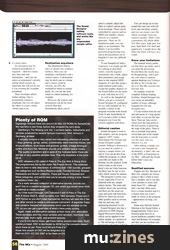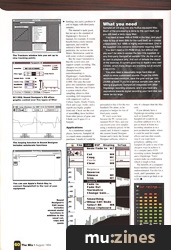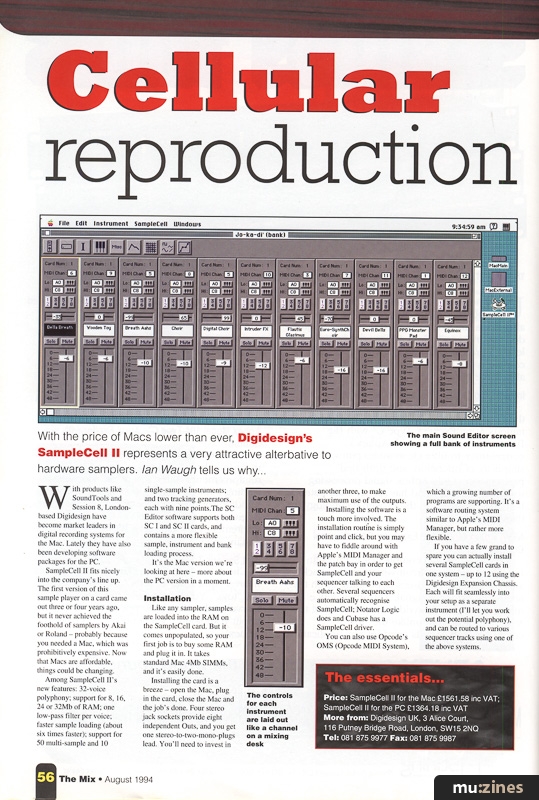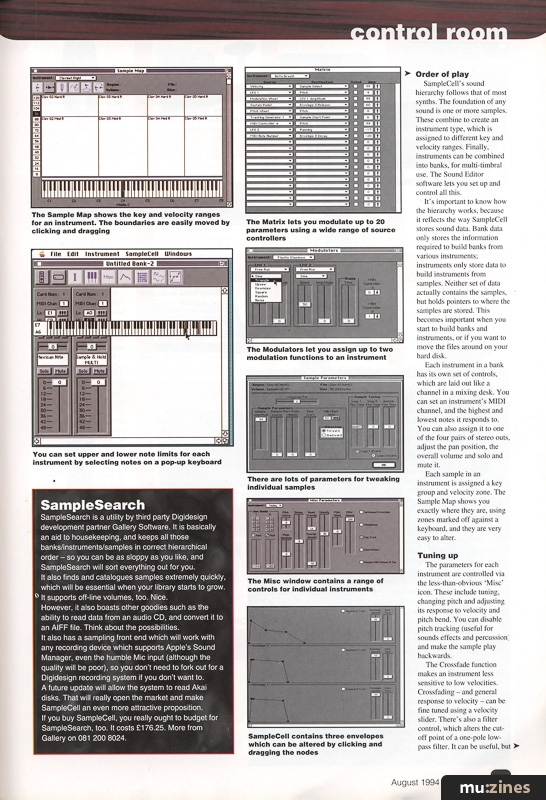Magazine Archive
Home -> Magazines -> Issues -> Articles in this issue -> View
Article Group: | |
Cellular reproduction | |
Digidesign SampleCell IIArticle from The Mix, August 1994 | |
Mac-driven sampling re-defined
With the price of Macs lower than ever, Digidesign's SampleCell II represents a very attractive alternative to hardware samplers. Ian Waugh tells us why...

The main Sound Editor screen showing a full bank of instruments
With products like SoundTools and Session 8, London-based Digidesign have become market leaders in digital recording systems for the Mac. Lately they have also been developing software packages for the PC.
SampleCell II fits nicely into the company's line up. The first version of this sample player on a card came out three or four years ago, but it never achieved the foothold of samplers by Akai or Roland - probably because you needed a Mac, which was prohibitively expensive. Now that Macs are affordable, things could be changing.

The controls for each instrument are laid out like a channel on a mixing desk
Among SampleCell II's new features: 32-voice polyphony; support for 8, 16, 24 or 32Mb of RAM; one low-pass filter per voice; faster sample loading (about six times faster); support for 50 multi-sample and 10 single-sample instruments; and two tracking generators, each with nine points.The SC Editor software supports both SC I and SC II cards, and contains a more flexible sample, instrument and bank loading process.
It's the Mac version we're looking at here - more about the PC version in a moment.
Installation
Like any sampler, samples are loaded into the RAM on the SampleCell card. But it comes unpopulated, so your first job is to buy some RAM and plug it in. It takes standard Mac 4Mb SIMMs, and it's easily done.
Installing the card is a breeze - open the Mac, plug in the card, close the Mac and the job's done. Four stereo jack sockets provide eight independent Outs, and you get one stereo-to-two-mono-plugs lead. You'll need to invest in another three, to make maximum use of the outputs.
Installing the software is a touch more involved. The installation routine is simply point and click, but you may have to fiddle around with Apple's MIDI Manager and the patch bay in order to get SampleCell and your sequencer talking to each other. Several sequencers automatically recognise SampleCell; Notator Logic does and Cubase has a SampleCell driver.
You can also use Opcode's OMS (Opcode MIDI System), which a growing number of programs are supporting. It's a software routing system similar to Apple's MIDI Manager, but rather more flexible.
If you have a few grand to spare you can actually install several SampleCell cards in one system - up to 12 using the Digidesign Expansion Chassis. Each will fit seamlessly into your setup as a separate instrument (I'll let you work out the potential polyphony), and can be routed to various sequencer tracks using one of the above systems.
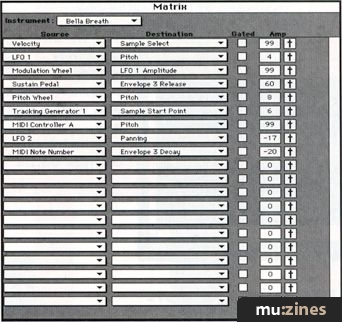
The Matrix lets you modulate up to 20 parameters using a wide range of source controllers
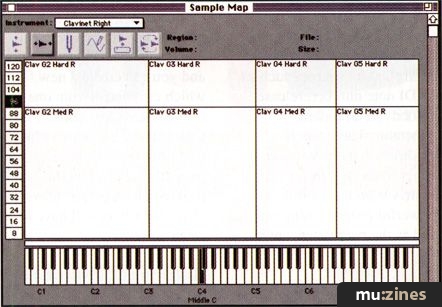
The Sample Map shows the key and velocity ranges for an instrument. The boundaries are easily moved by clicking and dragging

The Modulators let you assign up to two modulation functions to an instrument

You can set upper and lower note limits for each instrument by selecting notes on a pop-up keyboard
Order of play
SampleCell's sound hierarchy follows that of most synths. The foundation of any sound is one or more samples. These combine to create an instrument type, which is assigned to different key and velocity ranges. Finally, instruments can be combined into banks, for multi-timbral use. The Sound Editor software lets you set up and control all this.
It's important to know how the hierarchy works, because it reflects the way SampleCell stores sound data. Bank data only stores the information required to build banks from various instruments; instruments only store data to build instruments from samples. Neither set of data actually contains the samples, but holds pointers to where the samples are stored. This becomes important when you start to build banks and instruments, or if you want to move the files around on your hard disk.
Each instrument in a bank has its own set of controls, which are laid out like a channel in a mixing desk. You can set an instrument's MIDI channel, and the highest and lowest notes it responds to. You can also assign it to one of the four pairs of stereo outs, adjust the pan position, the overall volume and solo and mute it.
Each sample in an instrument is assigned a key group and velocity zone. The Sample Map shows you exactly where they are, using zones marked off against a keyboard, and they are very easy to alter.
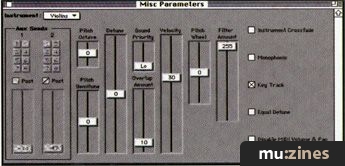
The Misc window contains a range of controls for individual instruments

There are lots of parameters for tweaking individual samples
Tuning up
The parameters for each instrument are controlled via the less-than-obvious 'Misc' icon. These include tuning, changing pitch and adjusting its response to velocity and pitch bend. You can disable pitch tracking (useful for sound effects and percussion), and make the sample play backwards.
The Crossfade function makes an instrument less sensitive to low velocities. Crossfading - and general response to velocity - can be fine tuned using a velocity slider. There's also a filter control, which alters the cutoff point of a one-pole low-pass filter. It can be useful, but it's pretty basic.
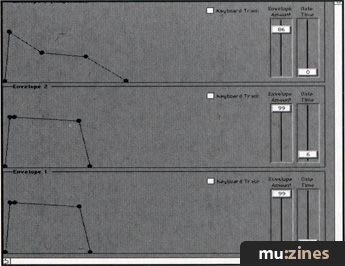
SampleCell contains three envelopes which can be altered by clicking and dragging the nodes
An instrument may be rendered monophonic if required - ideal for certain bass lines and solo instruments - and you can adjust an instrument's priority setting which ensures an important line will not be lost if you overstep the available polyphony.
Three envelopes afford further editing. One is permanently routed to amplitude, but you can adjust the others to create a delay vibrato and so on.
Destination anywhere
The Modulation Matrix takes us deeper into synthesis territory. Here you can modulate a destination with a control source. A destination may be pitch, pan or volume and a source could be velocity, an LFO, the modulation wheel or sustain pedal. So, you use the mod wheel to control panning, for example.
However, the sources and destinations can be far more esoteric than that. Destinations allow you to select a sample, adjust the filter or control various parts of an envelope. These can be controlled by sources such as MIDI note number, release velocity or a random generator. There are 20 modulation paths you can apply to an instrument. The Matrix is an incredibly powerful programming tool, and as the parameters are in English it's not very difficult to use.
To use SampleCell with a sequencer, you simply get the two talking as described earlier, load the required instruments into a bank, adjust their parameters and assign them to the required MIDI channels. It's just like using a multi-timbral synth really, except the graphic displays of the Sound Editor are far easier to work with than an LCD.
As well as the SampleCell Editor, you get a version of Sound Designer II, configured for use with SampleCell. It's actually a subset of the program included with Sound Tools II and AudioMedia II, so if you have either of these programs you'd use the version supplied with them.
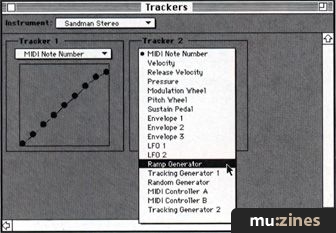
The Trackers window lets you set up to nine tracking points
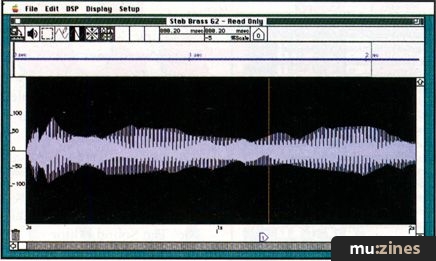
The Sound Designer editing software looks and works like any respectable sample editor
Editorial caution
Sound Designer is used to edit samples, and the program supports AIFF (Audio Interchange File Format) and Sound Designer sample formats. Editing is destructive, so you must be careful to backup a sample before you edit it. You can do this from within the program, in which case edits are made to the backup, not the original. If the worst comes to the worst there's also an Undo function, but there may be one or two edits which cannot be undone.
The program is pretty easy to use, especially if you've tinkered with any sample editors before. The main edit window shows the waveform, and there are the usual cut, copy and paste edit functions. However, there are several other goodies such as reverse, fade ins and outs, and optimising playback levels.

Sound Designer's EQ offers graphic control over five types of filter
Sound Designer also has a collection of DSP (Digital Signal Processor) functions which can be applied to the whole sample, or a portion of it. The advantage of digital processing, of course, is that it does not add noise to the sample, unlike analogue signal processing.
You can merge up to four sound files into one with full level, pan and delay control, and you can create a new file which crossfades from one sound to another. There's also a parametric EQ which offers five filter types: high pass, low pass, high shelf, low shelf and peak/notch. A graph shows the effect the filters will have on a sound.
Know your limitations

The looping function in Sound Designer includes autolocate functions
The manual wisely points out that there are limits, and if you push the processing beyond these the results may be disappointing. And it gets my vote when it cautions against thinking you'll always be able to 'fix it in the mix' (fix it in The Mix instead, heh heh heh, Ed).
No sampler would be complete without looping facilities. Sound Designer lets you create an unlimited number of loops, although SampleCell will only recognise two.
A Loop window butts the end and start points of a loop against each other, so you can fine tune them. There are Auto arrows which move the loop points to the next section, so preserving the slope of the splice. There is also a crossfade loop option, which fades part of the sample into the loop point, to smooth over the seam. And very effective it is, too.
After editing a sample you can load it into SampleCell. Incidentally, it didn't like one of the INITs or Extensions in my Mac - although the Sound Editor didn't raise any objections.
Qualified success
Niggles are few. Because of their size, samples are always going to take a while to load into a sampler, and it can take a few minutes to load a full bank from CD - although that's not bad. Most users have a colour monitor and it's a shame more use wasn't made of colour in the program - appearances do help, you know.
Some may find the limited filtering in the Sound Editor a disappointment. Filters have featured quite heavily in recent hardware samplers from Akai and Roland, for example, and they are an excellent tool if you're into creative synthesis. The lack of compatibility with other sample formats is also limiting; not such a problem if you're happy with third party samples.

You can use Apple's Patch Bay to connect SampleCell to the rest of your equipment
The manual is quite good, but not up to the standard of Digidesign's Session 8 manual, for example. It would benefit from a more tutorial approach, and could be ordered a little better. In particular, the section on the Matrix Modulation could do with some worked examples.
But the major limitation is that the system does not support sample recording. The cheapest recording option (SampleSearch notwithstanding) is Digidesign's AudioMedia, which retails for around £1000. This puts the total price into standalone sampler territory. But then you'll have a system which offers sampling, direct-to-disk recording, full integration with sequencers such as Cubase Audio, Studio Vision, Deck and Logic Audio, and a superb and highly graphic front end. Check out the cost of assembling these facilities from other pieces of gear, and I think you'll agree it's a bargain.
Applications
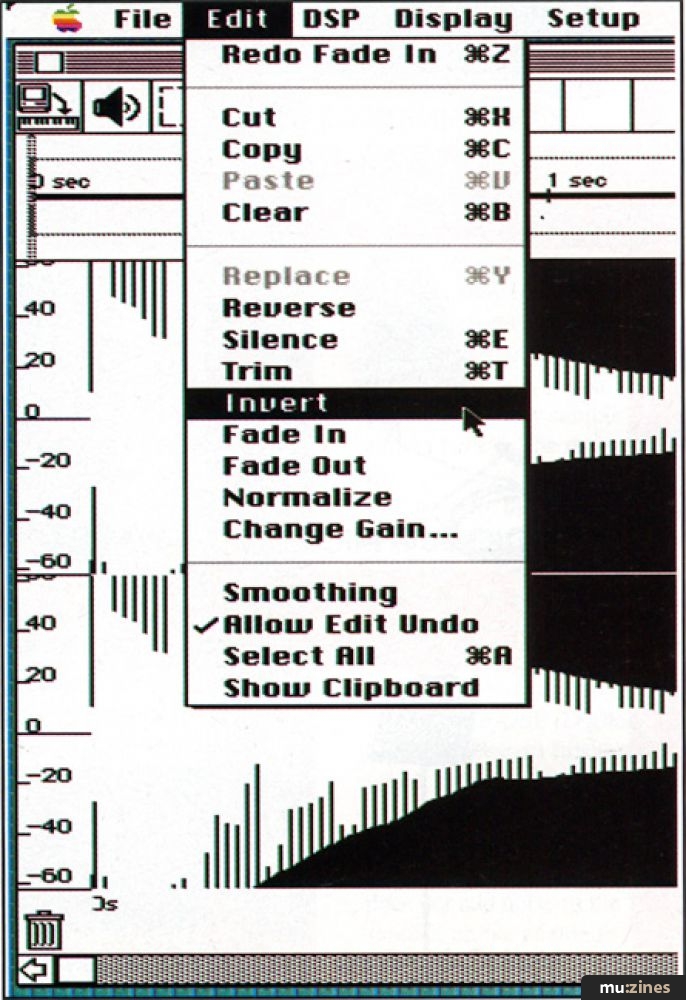
Sound Designer's Edit menu includes several useful functions in addition to the usual cut, copy and paste
As a standalone sample player, however, SampleCell is a much more considered purchase. I doubt if I could be persuaded to buy it for the two bundled CDs alone, so be prepared to budget for lots of third-party sounds.
PC users score here because the PC version uses standard WAV files, and you can record your own samples using a modestly-priced 16-bit sound card. It doesn't support the custom Sound Designer format and it lacks the Sound Designer software, which is why it's cheaper than the Mac card.
If you already have a Digidesign recording system such as SoundTools, SampleCell would be an excellent addition to it. It is just as much at home in a recording situation as in a post-production studio, where it could be used for sound effects and one-shot sounds. And if you want more polyphony, adding extra SampleCell cards is one of the cheapest ways to achieve it. As a sampler and a DTD recording system, SampleCell and a Digidesign 'Tools' system make an combination which is tough to beat.

The benefits of a computer-based interface should not be underestimated. Use this for a week, and I guarantee you will not want to go back to an LCD.
The essentials...
Price: SampleCell II for the Mac £1561.58 inc VAT; SampleCell II for the PC £1364.18 inc VAT
More from: Digidesign UK, (Contact Details)
SampleSearch
However, it also boasts other goodies such as the ability to read data from an audio CD, and convert it to an AIFF file. Think about the possibilities.
It also has a sampling front end which will work with any recording device which supports Apple's Sound Manager, even the humble Mic input (although the quality will be poor), so you don't need to fork out for a Digidesign recording system if you don't want to.
A future update will allow the system to read Akai disks. That will really open the market and make SampleCell an even more attractive proposition.
If you buy SampleCell, you really ought to budget for SampleSearch, too. It costs £176.25. More from Gallery on (Contact Details).
Plenty of ROM
Steinberg's The Missing Link Vol. 1 contains banks, instruments and samples produced by several famous musicians. Well, famous in Germany, at least.
It actually contains a very varied and interesting collection of sounds - dogs growling, gongs, tablas, unbelievably weird machine noises, lots of sound effects, drum loops and grooves, guitars, vintage analogue synths and drum kits, Mellotron sounds and ambient space noises.
The quality is excellent and in spite of the fruitcake factor there are still lots of very useable samples here. The only drawback is the price - £219.
OSC released a CD called A Poke In The Ear With A Sharp Stick. The programmers live by the motto 'No French Horns'. The collection does its best to defy description. It contains over 1350 sounds, grouped into categories such as Bass Replacements, Twisted Ethnoid, Warped Keyboards and Mutant Lifeforms. There are House, Industrial and Metal categories, and just in case you're actually writing a tune, there's a Melodics folder, too.
It's a really fantastic collection of alternative sounds, sounds you won't find on a traditional sample CD, and which you would never think to attempt to create yourself.
As if that wasn't enough, OSC followed it with A Poke In The Ear With A Sharp Stick II, which contains over 1800 samples. These are in AIFF format so you don't need SampleCell, but they will load into it like any other sample to create a one-sample instrument. A separate floppy disk contains SampleCell instruments which use the samples on the CD, so you can get a good idea of what's there pretty quickly.
Again, these are alternative samples at their most, erm, alternative. There are loops and hits, vocal samples and narration, machines, fake animals (yes, that's right), and ambient textures.
If you're into dance mixes, get these before anyone else does. Right upside-yo-head. OSC is distributed by MCM but the company doesn't stock these as yet. Poke I is $149 and Poke II is $199, and I'm sure those nice people at OSC will be delighted to supply you direct. Call them on (Contact Details).
What you need
You need at least 4Mb of RAM in the Mac, and you'll have to buy at least 8Mb for the card itself, as it comes unpopulated, but 16Mb is highly recommended. One of the supplied CDs contains instruments requiring 32Mb!
You don't need a CD-ROM drive, but without one you won't be able to access the two CDs supplied, or any third-party SampleCell sample CDs. As the unit on its own is playback only, that sort of defeats the object of the exercise. A current good buy is Apple's very own CD300, which many shops are knocking out at around £160-£170.
You also need a reasonably large hard disk on which to store customised sounds. Forget the 40Mb recommended minimum, save the grief and get 100-250Mb at least. If you're a serious sample user, we're talking a gigabyte. SampleCell integrates with other Digidesign recording products, and if you have any aspirations towards digital recording your hard disk can never be too large.
Featuring related gear
Publisher: The Mix - Music Maker Publications (UK), Future Publishing.
The current copyright owner/s of this content may differ from the originally published copyright notice.
More details on copyright ownership...
Control Room
Gear in this article:
Review by Ian Waugh
Help Support The Things You Love
mu:zines is the result of thousands of hours of effort, and will require many thousands more going forward to reach our goals of getting all this content online.
If you value this resource, you can support this project - it really helps!
Donations for November 2025
Issues donated this month: 0
New issues that have been donated or scanned for us this month.
Funds donated this month: £0.00
All donations and support are gratefully appreciated - thank you.
Magazines Needed - Can You Help?
Do you have any of these magazine issues?
If so, and you can donate, lend or scan them to help complete our archive, please get in touch via the Contribute page - thanks!


